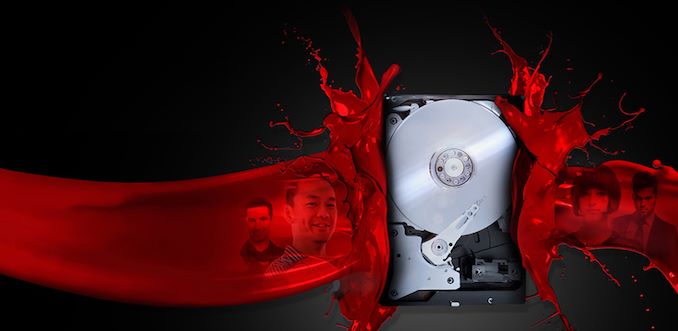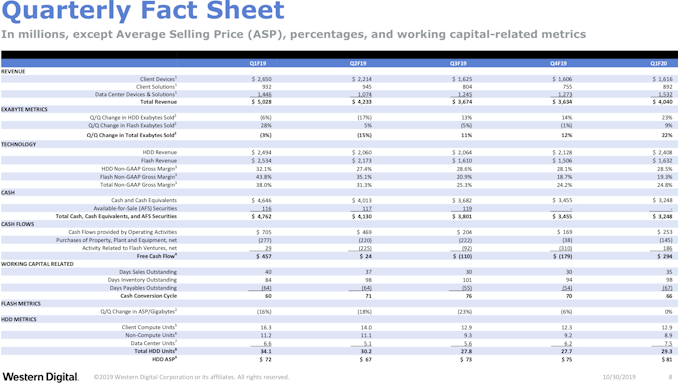Demand for HDD Storage Booming: 240 EB Shipped in Q3 2019
by Anton Shilov on November 18, 2019 3:00 PM EST
Demand for storage is stronger than ever as, in addition to growing user-generated data, machine-generated data now requires a formidable amount of storage space and will need even more in the future as the number of connected devices increases. Since the bulk of data continues to be stored on hard drives, it is not surprising that the third quarter was particularly successful for HDD makers, which despite the dent that flash sales are making, still set a record in terms of total shipped capacity.
Record 240 EB Shipped
The combined capacity of all of the hard drives sold by Seagate, Toshiba, and Western Digital in the third quarter totaled a whopping 240 exabytes (EB), of which 140 EB were nearline HDDs, according to TrendFocus. To put the number into perspective: the combined capacity of all HDDs and SSDs shipped last year was 912 EB and, today we are talking only about hard drives in one quarter. In fact, even when compared to Q2’s 207.5 EB, this is still 15% growth.
Market observers are attributing the significant rise in shipping HDD capacity to increasing shipments of enterprise-class nearline 14 TB, 15 TB, and 16 TB hard drives, which by now have been qualified by a substantial number of companies. For example, the average capacity of Seagate’s enterprise HDD (mission critical + nearline drives) was 6.3 TB in Q3 2019, up from 5.2 TB in the same period last year. By contrast, the average capacity of Seagate’s client hard drives was at 1.2 TB (unchanged from Q3 2018), as the bulk of such drives are intended for notebooks and their capacities range from 500 GB to 1 TB. In terms of units shipped, client and consumer electronics HDDs by far outsell enterprise and nearline drives, so, the average capacity of a Seagate HDD is 2.9 TB, up from 2.5 TB a year ago.
Unit Shipments Down
When it comes to total unit shipments however, not everything is quite as rosy, based on data from TrendFocus. The three manufacturers sold 83 million HDDs in the third quarter, up from 78.6 million in Q2 and 78 million in Q1, but down from around 88 million in the same quarter of 2018. In fact HDD sales have been in decline for a long time. Nidec, a Japanese motor manufacturer who is responsible for around 85% of all HDD spindle motors, said earlier this year that unit sales of hard drives had declined by around 43% from 2010 to 2018, going from around 650 million units in 2010 to 375 million units in 2018. Based on Nidec's forecast, HDD shipments will drop to 309 million drives in 2019, which will further drop to 290 million units in 2020.
Market Shares
When it comes to market shares in Q3 2019, Seagate was leading the pack with a 40.2% share, Western Digital followed with 35.4%, whereas Toshiba trailed with 24.4% of HDD unit shipments.
For readers interested to learn more about Seagate’s and Western Digital’s HDD businesses today, we included some supplementary information below.
Related Reading:
- Shipments of PC Hard Drives Predicted to Drop By Nearly 50% in 2019
- Seagate: 18 TB HDD Due in First Half 2020, 20 TB Drive to Ship in Late 2020
- Cray Unveils ClusterStor E1000 Storage Arrays: HDDs and SSDs, 1.6 TB/s per Rack
- Western Digital Reveals 18 TB DC HC550 'EAMR' Hard Drive
- Western Digital 20 TB HDD: Crazy Capacity for Cold Storage
- Western Digital: Over Half of Data Center HDDs Will Use SMR by 2023
- Toshiba's HDD Tech Roadmap: A Mix of SMR, MAMR, TDMR, and HAMR
- 18 TB HDDs: Toshiba Collaborates with Showa Denko for MAMR HDDs
Sources: StorageNewsletter/TrendFocus, Seagate, Western Digital












27 Comments
View All Comments
nathanddrews - Tuesday, November 19, 2019 - link
We all knew it would come to this. The a la carte model is ultimately more expensive, but offers greater flexibility and choice. We have Netflix ($14/mo), Amazon Prime ($8/mo), and Disney+ ($4/mo) as the only paid subscriptions in our house. We don't really use Prime for video watching, it's just a bonus, but I'll count it anyway. Right now, that's $26/mo for nearly all the content we want and way more than we could every watch in a lifetime... with no ads (Prime still has pre-roll ads for their own content sometimes). On top of our $50/mo internet, that's $76/mo.I also buy lots of 4K Blu-rays and back them up on my ~70TB Plex server. The recent 10TB WD deals have helped out a lot.
GreenReaper - Monday, November 18, 2019 - link
Not just for desktop or consoles - in the server world, I'm seeing configurations with 4x480GB lease for the same amount as 6x4TB. €59/month servers, admittedly with outdated Westmere-era CPUs.Now, this is still quite a price premium in usable storage, but it reflects the fact that many people will be *quite* happy with 1-1.5TB and lots of IOPS after RAID, even on a system with a 1GB hardware capacitior-backed DRAM cache to absorb writes.
The rise in hard disk capacity has been driven by the need to retain a role in media storage. But SSD flash is catching up faster and is now the default; HDD+NVMe has taken over the high-end.
willis936 - Tuesday, November 19, 2019 - link
It blows my mind that someone can still turn a profit while paying to keep a westmere era machine on. A newer system could handle a 10x the clients (due to RAM density) and have the same operating cost.PeachNCream - Tuesday, November 19, 2019 - link
Considering usage and demand is important in calculating profitability. If said westmere box was never in high demand or adversely impactful of productivity, then why bother to replace it just ot have faster hardware when the faster hardware will do nothing to make your business or workload more efficient? This sort of thing is turning up all over the place as people stretch hardware lifespans outward because their ancient junk is still more than fast enough for a given workload and newer equipment, though faster, isn't going to offer much even in terms of power efficiency.GreenReaper - Tuesday, November 19, 2019 - link
Sure, but... we don't actually *need* that much RAM. With the combination of optimization of memory use in languages, and databases running on SSD (so not needing quite as much cached for good performance), memory requirements per user has decreased. Serving files uses almost no CPU, except a bit for SSL encryption (and even then, it's like one tenth of one core).I guess you're thinking about the VPS hosting use-case, but we're running a web application, and given our storage and transfer requirements, leasing main server hardware is a much better value. (Don't even talk to me about true cloud - it'd be 10x the price for our transfer alone.)
evernessince - Tuesday, November 19, 2019 - link
I highly doubt next gen consoles get rid of HDD altogether given the price of an all SSD solution. $100 for 1TB of space is a lot to add to the price of a console. 500GB won't cut it either, by the time the consoles launch that's not enough space for a decent game library. More then likely they are using something akin to an SSHD. A large flash cache on top of a HDD. All the benefits of an SSD and a HDD. If the cache is appropriately sized, the end user shouldn't notice a difference.azfacea - Monday, November 18, 2019 - link
unit shipments down 50% since 2010. thats the headline. the question is how long for another 50% hit to unit shipments at which HDD will start to get literally more expensive per GB as SSDs get cheaper. my money is on 2021eastcoast_pete - Monday, November 18, 2019 - link
As long as people want to store surveillance footage by the thousands of terabytes, HDDs won't go away. They're still the cheapest way to store such vast quantities of data, and are also still better for cold storage.waterdog - Tuesday, November 19, 2019 - link
Spinning disks will be with us until SSD technology can accommodate long term dead storage. Once that happens, I can see the spinning disks disappearing very rapidly.On to a more important question: The banner graphic at the top of the article suggests that disk drives are made from the blood or souls of the damned. Is this accurate?
Lord of the Bored - Wednesday, November 20, 2019 - link
I believe that impression is, in fact, correct. That's what the noise they make when they're running comes from, the souls wailing to get out.